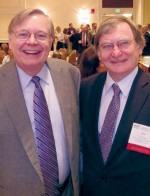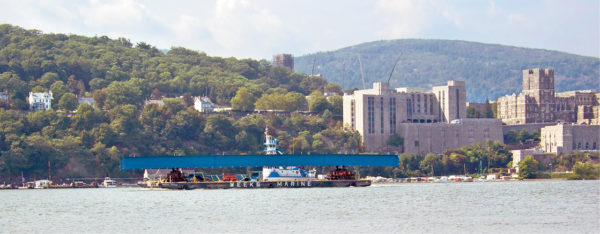Business Council pursues the grail of fast, frequent rail service
A train trip from Stamford to Manhattan in 30 minutes would provide quantifiable paths for job growth and for real estate values. Continuing the status quo ”” about 52 minutes to Grand Central Terminal ”” would not be fatal, but could lead to economic stagnation with regional growth a comparative iron horse in a bullet-train world.
A three-person panel assembled by the Business Council of Fairfield County and representing planning, infrastructure financing and business interests recently told a room of 120 at the Stamford Marriott the half-hour trip ”” coupled with service improvements between New Haven and Bridgeport and between Bridgeport and Stamford ”” would be a boon.
But in the words of emcee Joseph McGee, vice president for public policy and programs for the Business Council, “If we don”™t invest in our rail system, this economy grows slowly.” He noted Stamford had 83,000 jobs in 2000Â and today it has 75,000.
The Business Council said in a statement accompanying its “30 Minutes to Manhattan” breakfast, “Our mobility within the metro New York region is critical to our economic vitality. New York and New Jersey have invested not only in good repair, but have invested in increasing capacity, with subsequent impact on real estate values adjacent to transit centers.”
“This is about reliably and frequently reducing the distances between the economic centers of Connecticut and one of the world”™s great economic engines in New York City,” Chris Bruhl, Business Council president and CEO, said.

- Stamford Mayor David Martin, left, and Joseph McGee, event emcee and vice president, Business Council of Fairfield County.
“We have some big choices to make and we have to prioritize,” McGee said. “We can sit back and have the same old New Haven line. It”™s not bad. It works. But if we want to drive economic growth, we need to act.”
The panelists were Thomas Wright, president of the nonprofit Regional Plan Association, with offices in Stamford, New York City and Princeton, New Jersey; Steve Gallucci, managing partner, Deloitte”™s New York practice and Jeff Parker, founder and principal, New York City-based Parker Infrastructure Partners, an infrastructure investment platform.
In addition to the Business Council, event hosts were NAIOP Commercial Real Estate Development Association of Connecticut and Suburban New York and the Stamford Downtown Special Services District. JLL Vice President John Stoddard, who also serves as chairman of the NAIOP Program Committee, began the proceedings by citing both the challenges of funding New Haven Line upgrades and the “critically important” place the regional rails play in the Boston-to-Washington, D.C., corridor.
Wright noted the corridor constitutes just 2 percent of U.S. land, but makes up 20 percent of the nation”™s economic output.
After the meeting, the Business Council stressed cooperation as key to success.
“The Business Council believes a strong rail connection to the global center that is New York is critical to the economic strength of our region,” officials said. “That is why we partnered with NAIOP and Stamford Downtown to invite speakers who are experts in the field of existing transportation connections between New Jersey, New York and Connecticut ”” and in the field of infrastructure investment financing ”” as it is an expensive proposition for government to take on alone.”
“This is an advocacy political movement,” McGee said. “If we have support, we have a chance of success.” But the clock is ticking and he said, “When Jersey figures out its tunnels, it will grow.”
McGee had already called the recession”™s recovery “wildly uneven,” favoring Northern New Jersey and New York City.
Panel member Wright said, “If the new jobs are not going to New York City residents, the odds are 90 percent they”™re in northern New Jersey.”
Wright, who also had used “wildly uneven” to describe the recovery, said, “We”™re seeing employment pouring into the urban cores, particularly into New York City. This is the future we”™re seeing right now.”

- Mostly rail traffic, but also the region”™s roads ”“ including the proposed multibillion-dollar remake of the Interstate-84 interchange at Waterbury ”“ were discussed at the Business Council event. Here, a beam for the new Tappan Zee Bridge passes the U.S. Military Academy at West Point recently. The Interstate-287 link is now past the halfway mark for construction.
The audience learned, among rafts of pro-transit/pro-growth facts, that a home within a half mile of a train station picks up $3,000 for every minute lopped off the trip to Manhattan. It also learned the MTA”™s model is not the only one in the world; Stockholm, for example, subcontracts its subway operations from Hong Kong.
The audience included Mayor David Martin of Stamford and First Selectman Jayme Stevenson of Darien. Attendees were urged at program”™s end to contact the Business Council with feedback. The council”™s public/private Transportation Stakeholders Alliance, of which Deloitte”™s Gallucci is co-chairman, is leading the initiative.